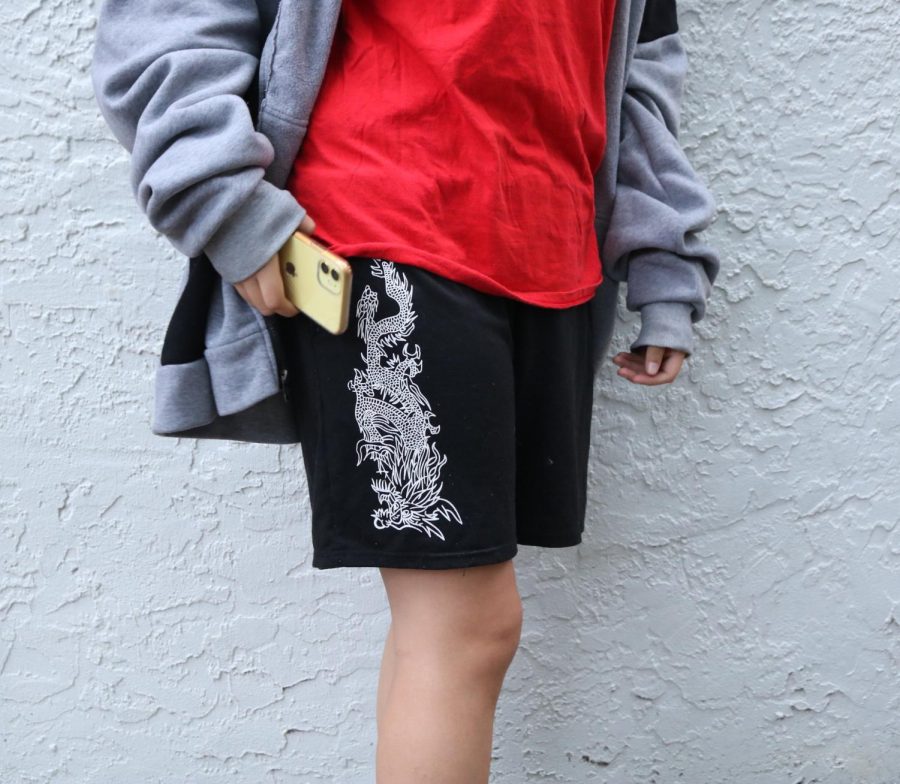Shein Loses It’s Shine
Isabella Piccolo sits crisscross inside a closet, posing with Shein bought clothes all around her.
April 4, 2023
Buying new clothes every two weeks may sound outlandish, but that’s exactly what South Broward High School junior Georgina Paez did. Over the course of two years, Paez would routinely scroll through an app on her phone connected to the fast-fashion company Shein. She purchased everything the site had to offer- frilly shirts, baggy sweatpants, tiny bikinis, and even jewelry, all of which were less than $10 each.
“I just got obsessed because of how low the prices were,” she said.
But it turns out the prices were, in fact, too good to be true. According to Paez, she ended up throwing out or donating most of the clothes she bought off the site because the quality of the clothes was “horrible.”
“They usually only lasted a couple of weeks before falling apart,” said Paez. “Even though the clothes were cheap, I was losing more money by having to throw them out so often.”
Now, she likes to get her outfits from higher quality brands like Hollister and a particular boutique store in Miami that she fell in love with.
Paez is just one of many people who have bought their wardrobe from Shein, and while she has since stopped, there are plenty who still cycle through the cheap clothes weekly.
With fashion options ranging from $2 a shirt to $10 a skirt and easy access via a phone app, it’s no wonder cash-strapped teens spend their time online shopping there.
SBHS senior Ariana Genao is very familiar with Shein, and gets most of her clothes from the website.
“I’ve spent like $400 dollars on Shein,” said Genao.
Genao recognizes the cheap material of the majority of the clothes she receives, but continues to buy because of the low prices.
“It’s worth it because I’m able to find my style of clothes on Shein, and I can’t really get that anywhere else,” said Genao.
Although there are other fast-fashion conglomerates like AliExpress and Romwe, none represent the overproduction and consumption cycle of cheap clothing like Shein. Founded in 2008, most of their products were sold locally in China. But, when they began marketing fashion to the Western Hemisphere, company profits skyrocketed.
In 2020, Shein posted profits of $9.81 billion. And, in 2021 profits increased 60%, to a total of $15.7 dollars, making Shein the top shopping app on the phones of American consumers.
The low prices of fast fashion companies such as Shein may be attractive to a customer looking for a deal, but many who shop there are often disappointed by the clothing they receive.
Sacrificing the quality of clothes because they’re your style is a choice many people have made since the rise of fast fashion websites like Shein, but the decision has unforeseen consequences.
According to the magazine “Business Insider,” the fast-fashion industry contributes over 92 million tons of waste every year. And, that number continue to rise with the drop of clothing life expectancy. A CNN article estimated the average life expectancy for clothing worn everyday to be no more than two years. But statistics posted by “The Guardian” show most Shein shoppers will throw out clothing after just a wears.
SBHS freshman Ariela Brody learned about Shein through Tiktok three years ago, but never bought anything from the website, preferring to buy most of her clothing at thrift stores.
“Even though the clothes on Shein were cute, I knew how bad fast fashion was for the environment,” said Brody.
Clothes that end up in landfills can take 200 years to fully decompose, and greenhouse gasses and toxins are released in the process. According to the BBC, 85% of clothes in the United States end up in landfills or are burned. With the rise of fast fashion in recent years, Brody believes the number will continue to grow.
“The clothes on Shein are very trendy, so in a month something you bought could already be out of date, which is why people buy so often,” said Brody.
Shein caters to the younger generation, and with the internet constantly providing consumers with new fashion micro trends, Shein and other fast fashion companies have to work twice as hard to keep up with the wants of their customers. According to Shein revenue and usage statistics, they produce 2,000 new items a day on average for shoppers to buy. Workers work 18 hours a day for about $3.50 for each piece of clothing made according to a report made by Britain’s Channel 4.
“It’s cruel to put the workers under such bad working conditions to make clothes that’ll be thrown out in a week,” said Brody.
Shein refuted the claims, but Channel 4’s investigation shows evidence of the exploitative conditions described in their report.
“By the time people realize the damage fast fashion does overall, it’ll be too late to do anything about it,” said Brody.




